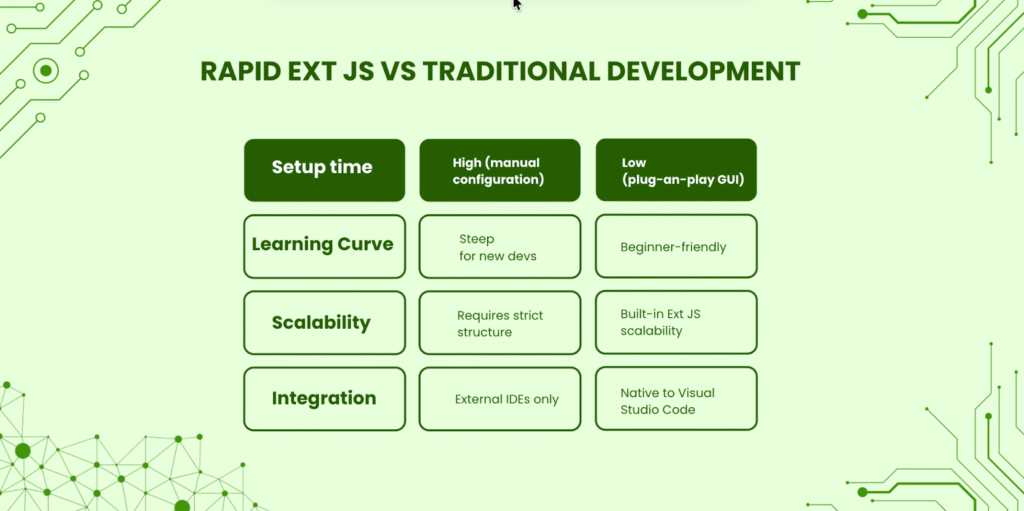In today’s hyper-competitive technology landscape, Rapid Application Development (RAD) has become essential for keeping up with market demands and user expectations. Enterprises and developers alike are under immense pressure to deliver high-quality, scalable, and feature-rich applications in shorter timeframes — all while maintaining UI consistency and performance.
Traditional development approaches often fall short in meeting these demands. Developers spend days or even weeks writing repetitive UI code, managing frameworks, and debugging layout inconsistencies. That’s where Rapid Ext JS, Sencha’s next-generation low-code tool for Ext JS, steps in. Designed for enterprise-grade applications, it streamlines the front-end development process with visual design tools, pre-built components, and seamless integration with Ext JS.
Rapid Ext JS accelerates the RAD workflow, empowering developers to build robust, scalable, and data-rich applications in a fraction of the time — without sacrificing performance or flexibility.
Understanding Rapid Application Development (RAD)
What is RAD and Why It Matters
Rapid Application Development (RAD) is a methodology focused on speed, iterative prototyping, and user feedback rather than lengthy development cycles. It promotes rapid iterations, shorter release timelines, and close collaboration between developers and stakeholders.
In industries where “time to market” determines success — such as fintech, logistics, and SaaS — RAD helps deliver production-ready applications in weeks instead of months.
Key Benefits of RAD
- Faster Time-to-Market – Development cycles are shortened by reusing components and embracing automation.
- Higher Flexibility – Continuous iteration allows for rapid improvements.
- Reduced Costs – Fewer manual processes and smaller dev teams translate into measurable ROI.
- Stronger Collaboration – Encourages communication between technical and non-technical stakeholders.
The Role of Low-Code in RAD
Low-code platforms like Rapid Ext JS play a pivotal role in enabling RAD. By combining drag-and-drop design tools, reusable UI components, and auto-generated code, they let developers create sophisticated enterprise interfaces without hand-coding every detail.
In essence, low-code tools deliver speed without sacrificing structure, allowing teams to focus on business logic instead of boilerplate UI code.
What Is Rapid Ext JS?
Rapid Ext JS is Sencha’s latest low-code development environment designed to accelerate the creation of Ext JS applications. Integrated directly into Visual Studio Code, it brings drag-and-drop design, real-time previews, and automated code generation to developers focused on custom software development, delivering efficiency and scalability in every project.
Key Highlights
- Low-Code Visual Design: Build sophisticated apps with minimal manual coding.
- 140+ Pre-Built Ext JS Components: Use ready-made grids, charts, and forms.
- Real-Time Preview: View UI updates instantly without refreshing or redeploying.
- Cross-Platform Support: Design responsive apps for desktops, tablets, and mobile devices.
Ideal Use Cases
- Enterprise Dashboards
- Data-Intensive Applications
- CRM and ERP Systems
- Internal Business Tools
By bridging the gap between development speed and enterprise requirements, Rapid Ext JS acts as a catalyst for RAD-friendly front-end development.
Why Developers Prefer Rapid Ext JS for RAD
Pre-Built UI Components
One of the biggest advantages of Rapid Ext JS is access to 140+ enterprise-grade UI components, such as:
- Grids with advanced sorting, filtering, and grouped data views
- Charts for real-time analytics
- Forms, Trees, and Pivot Grids for structured, data-driven UX
Ext.create(‘Ext.grid.Panel’, {
title: ‘Sales Dashboard’,
store: {
fields: [‘region’, ‘sales’, ‘growth’],
data: [
{ region: ‘North’, sales: 120000, growth: 12 },
{ region: ‘South’, sales: 98000, growth: 8 },
{ region: ‘West’, sales: 143000, growth: 16 }
]
},
columns: [
{ text: ‘Region’, dataIndex: ‘region’, flex: 1 },
{ text: ‘Sales ($)’, dataIndex: ‘sales’, flex: 1 },
{ text: ‘Growth (%)’, dataIndex: ‘growth’, flex: 1 }
],
height: 300,
width: 500,
renderTo: Ext.getBody()
});
Instead of coding this grid manually, Rapid Ext JS lets developers drag it into their design canvas, customize bindings, and preview the output instantly.
Drag-and-Drop Visual Editor
Rapid Ext JS provides a drag-and-drop interface that allows developers to rapidly design and rearrange UI components without code interruptions.
For example, a developer can:
- Drag a form panel onto the canvas.
- Add components like text fields, dropdowns, and buttons.
- Define their properties directly in the configuration panel.
This kind of visual prototyping drastically reduces both development time and human error — a cornerstone principle of RAD.
Seamless Integration with Ext JS
Unlike generic RAD tools, Rapid Ext JS is purpose-built for Ext JS, ensuring 100% framework compatibility. It adheres to Ext JS’s MVC/MVVM architecture, promoting maintainable and scalable codebases.
Projects built in Rapid Ext JS can be seamlessly exported to Ext JS projects for continued manual enhancement.
Bonus: You can import existing ExtGen or Sencha CMD-based projects directly into Rapid Ext JS — no need to start from scratch.
Accelerated Prototyping and Iteration
With real-time previews, Rapid Ext JS eliminates long build-refresh cycles. Developers can modify layout components, update configurations, or swap data sources — and see the results instantly.
Use the built-in screen resolution selector to preview different device views (desktop, tablet, mobile). Rapid iterations mean stakeholders see updates faster, gathering feedback early and often.
Reduced Development Costs
Low-code development means lower overhead. Companies can deploy smaller front-end teams without compromising on output quality. Developers focus on business logic and integrations while Rapid Ext JS handles layout, design, and responsiveness.
Compared to traditional Ext JS or Angular-based development, teams using Rapid Ext JS report up to 60% reduction in delivery time and a significant cut in development costs.
Responsive, Cross-Platform UIs
Modern enterprises demand multiplatform accessibility. Rapid Ext JS delivers responsive layouts that adjust dynamically across browsers and devices. Its built-in support for adaptability and accessibility standards ensures inclusive and device-friendly enterprise experiences.
Real-World Benefits for Developers
- Massive Productivity Boost: Use pre-tested components to achieve enterprise-grade applications faster.
- Rapid Onboarding: The visual interface makes it easier for new team members to understand the code structure.
- Less Repetitive Work: Focus on creating unique business logic instead of rewriting UI boilerplate.
- High Consistency: Uniform design and behavior across all projects.
- Innovation-Driven Development: With less time spent on framework setup, developers concentrate on new features.

Rapid Ext JS vs Traditional Development Tools
| Criteria | Traditional Development | Rapid Ext JS |
| Setup Time | High (manual configuration) | Low (plug-and-play GUI) |
| Coding Requirement | Full hand-coding | Low-code with visual editor |
| Prototyping | Slow (manual edits) | Fast (real-time previews) |
| Learning Curve | Steep for new devs | Beginner-friendly |
| Scalability | Requires strict structure | Built-in Ext JS scalability |
| Integration | External IDEs only | Native to Visual Studio Code |
Rapid Ext JS offers the perfect balance: visual control + full-code flexibility. You can design graphically and then deep-dive into the generated code for customization or optimization.
Conclusion
In an era where speed, scalability, and consistency define success, Rapid Ext JS emerges as the definitive choice for Rapid Application Development. It empowers developers with a robust low-code environment, a rich Ext JS component library, and an intuitive drag-and-drop interface — all within Visual Studio Code.
As enterprises demand faster solutions without sacrificing quality, Rapid Ext JS provides the agility to prototype, iterate, and deploy in record time. Developers can move from idea to execution swiftly while maintaining Ext JS’s proven scalability and performance.
FAQs
1. How do low-code tools support RAD?
Low-code tools accelerate RAD by combining visual design interfaces, reusable components, and auto-generated code, reducing manual effort and shortening iteration cycles.
2. Do low-code platforms completely remove the need for coding?
No. They minimize repetitive tasks, but developers can still refine back-end logic, handle integrations, and customize UI behavior with full control.
3. How does Rapid Ext JS support Rapid Application Development (RAD)?
Rapid Ext JS integrates low-code design, real-time previews, and Ext JS compatibility. It enables faster app creation, smoother collaboration, and scalable, production-ready code without heavy manual coding.






